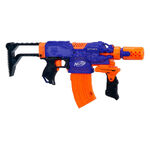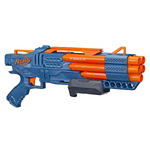A number code helps tell how many darts a Nerf blaster has, how a blaster is loaded or fired, and what type of blaster it is.
N-Strike number codes are "standard" number codes used for N-Strike blasters. Some other blasters feature these types of codes as well, most notably N-Strike Elite and N-Strike Modulus blasters.
List of number codes[]
N-Strike[]
These number codes include those that were first introduced with N-Strike blasters. Some would later be used for N-Strike Elite and N-Strike Modulus blasters.
Air system (AS)[]

The Hornet AS-6, an example of an AS blaster.
Main article: Air system
Air system blasters store air within a tank or bladder for use to fire darts. Often, they feature an option to fire all their darts at once.
Air system vessel (AS-V)[]

The Titan AS-V.1, the only AS-V blaster.
Main article: Air system vessel
The air system vessel blaster, the Titan AS-V.1, is similar to an air system blaster, except that it is a lot larger. The word "vessel" in its code possibly refers to the fact that other blasters can be attached to it via inverse tactical rail.
Clip system (CS)[]

The Longshot CS-6, an example of a CS blaster.
Main article: Clip system
Clip system blasters feature the use of interchangeable clips and drums. They fire standardized, uniform dart types, such as Streamline Darts and Elite Darts.
Electronic clip system (ECS)[]

The Stampede ECS, an example of an ECS blaster.
Main article: Electronic clip system
Electronic clip system blasters are battery-powered, not requiring manual priming. They either feature a semi-automatic or automatic firing mode.
Electronic belt-fed (EBF)[]

The Vulcan EBF-25, the only EBF blaster.
Main article: Electronic belt-fed
The electronic belt-fed blaster, the Vulcan EBF-25, is battery-operated; unlike other battery-operated blasters, it also features a manual-fire, bolt-action priming mechanism. It is belt-fed.
External mechanism (EX)[]

The Nite Finder EX-3, an example of an EX blaster.
Main article: External mechanism
External mechanism blasters are muzzle-loaded and feature an external plunger rod for priming . Most, if not all of external mechanism blasters have direct plunger internals.
Internal mechanism (IX)[]

The Scout IX-3, an example of an IX blaster.
Main article: Internal mechanism
Much like its external mechanism counterpart, internal mechanism blasters are muzzle-loaded. However, as their code suggests, these blasters have internal priming mechanisms instead of an orange ring pullback. Currently, all blasters in this category have reverse plunger internals.
Revolver (REV)[]

The Maverick REV-6, an example of a REV blaster.
Main article: Revolver
Revolver blasters feature the use of a cylinder. Often than not, they are slide-action or hammer-action, and are easier to dual-wield than others.
Electronic revolver (RV)[]

The Barricade RV-10, the only RV blaster.
Main article: Electronic revolver
The electronic revolver blaster, the Barricade RV-10, is a battery-operated revolver-style blaster. Rather than use a plunger system, it fires darts via flywheels.
N-Strike Elite[]
These number codes include those which were introduced after the original N-Strike codes, mostly being introduced with N-Strike Elite blasters, although some codes such as ICS were introduced with N-Strike Modulus blasters.
Close quarters (CQ)[]

The Stryfe CQ-10, an example of a CQ blaster.
Main article: Close quarters
Close quarters blasters come packaged with smaller accessories, to suit them better for close quarters-type play. It may be the only N-Strike number code to not relate to the blaster's internals or performance.
Dart shell (DS)[]

The Trilogy DS-15, an example of a DS blaster.
Main article: Dart shell
Dart shell blasters require the use of Elite Shells to fire darts. As all DS blasters only fire one shell at a time, the number in the number code denotes how many total darts the blaster can store via its shell storage (ie. the Trilogy DS-15 can store five shells in its stock; its number code is 5×3, or 15).
Indexing clip system (ICS)[]

The Battlescout ICS-10, an example of an ICS blaster.
Main article: Indexing clip system
Indexing clip system blasters are clip-loaded blasters that index their clips through them automatically. Despite their name, they are not compatible with clip system clips and drums.
Internal clip system (ICS)[]

The Shadow ICS-6, an example of an ICS blaster.
Main article: Internal clip system
Internal clip system blasters feature a non-removable, internal clip to hold darts. Despite its name, it is not compatible with clip system clips and drums.
Alpha Strike[]
These number codes include those which were introduced with Alpha Strike blasters, although some codes such as RD were introduced with Elite 2.0 blasters.
Double barrel (DB)[]

The Tiger DB-2, an example of a DB blaster.
Main article: Double barrel
Double barrel blasters feature two barrels, or sets of two barrels. The blaster may be single fire like the Tiger DB-2, or may have a set of twin barrels that are capable of multi-fire, like the Warden DB-8.
Long range (LR)[]

The Wolf LR-1, an example of an LR blaster.
Main article: Long range
Long range blasters are blasters that appear to be "sniper-style" blasters, featuring accessories like scopes. Like close quarters blasters, the number code does not reflect the blaster's operation or capacity. In fact, LR does not necessarily mean that the blaster is able to fire longer ranges than non-LR blasters.
Penta dart (PD)[]

The Ranger PD-5, the only PD blaster.
Main article: Penta dart
Penta dart blasters, as their name suggests, feature a five dart capacity. It is one of the few number codes where the initial also denote the capacity alongside its number.
Quad shot (QS)[]

The Fang QS-4, an example of a QS blaster.
Main article: Quad shot
Quad shot blasters, as their name suggests, feature a four-dart capacity and four barrels. It is one of the few number codes where the initials also denote the blaster's capacity alongside its number.
Rotating cylinder (RC)[]

The Cobra RC-6, an example of an RC blaster.
Main article: Rotating cylinder
Rotating cylinder blasters are identical to revolvers, and feature a rotating cylinder. The RC code can be thought of as a successor to the REV code.
Rotating drum (RD)[]

The Shockwave RD-15, an example of an RD blaster.
Main article: Rotating drum
Rotating drum blasters are similar to revolvers and rotating cylinder blasters, and feature a rotating drum. Some drum blasters feature high capacity drums, while others may only hold a few darts. The RD code seems to have completely replaced the RC code, as cylinder-fed blasters such as the Commander RD-6 use the RD code instead.
Single dart (SD)[]

The Stinger SD-1, an example of an SD blaster.
Main article: Single dart
Single dart blasters, as their name suggests, feature a single shot capacity. It is one of the few number codes where the initials also denote the blaster's capacity alongside its number.
Triple dart (TD)[]

The Trio TD-3, the only TD blaster.
Main article: Triple dart
Triple dart blasters, as their name suggests, feature a three dart capacity. It is one of the few number codes where the initials also denote the blaster's capacity alongside its number.
Other number codes[]
The following series feature their own set of number codes; these, however, do not feature any acronyms that have a specific meaning.
BioSquad[]
The Zombie Strike Biosquad blasters had a number code titled "ZR", most likely standing for Zombie Repellent. Like RIVAL, the ZR is then followed by a number indicating how many darts it can hold.
Dart Tag[]
Some 2012 Dart Tag blasters, such as the Quick 16 and the Speedload 6, feature a simple number after the name of the blaster, to denote how many darts it holds.
RIVAL[]
RIVAL blasters have number codes in their name, in the form of Roman numerals indicating its year of release. An "M" denotes if a blaster is battery-operated and motorized. This is followed by the amount of High-Impact Rounds the blaster in question can hold; every hundred in a RIVAL blaster's name means how much High-Impact Rounds can be loaded. 1000 is shortened with a "K", rather than an "M", since it is already in use.
For example, the Apollo XV-700 is a blaster that was released in 2015 and has a stock capacity of seven rounds. As another example, the Nemesis MXVII-10K is a motorized blaster that was released in 2017 and has a stock capacity of one hundred rounds.
Interestingly, re-releases of blasters retain the same year and capacity code, regardless of whether or not they have a new stock capacity or were released in a later year. For example, the Phantom Corps Apollo XV-700's code remains the same as its 2015 predecessor, although it was released in 2017 and has a new stock capacity of twelve rounds; it is not named "Apollo XVII-1200", as one would expect. This trend is not followed with N-Strike number codes, as re-releases/direct successors of blasters usually feature updated codes, such as the Alpha Trooper CS-12, and its successor, the Alpha Trooper CS-6.
Trivia[]
- The Longshot CS-12 is the only Zombie Strike blaster to follow the conventional N-Strike number code; this can be explained by the fact that it is a Z.E.D. Squad re-release of the Longshot CS-6.
- The Rough Cut 2x4 has its own non-standard number code, simply denoting its ammunition layout and capacity.
- The Nerf N-Strike and Nerf N-Strike Elite video games feature fictional blasters with their own fictional number codes, such as the BullSharc GL-8 and the Spartan NCS-12.
